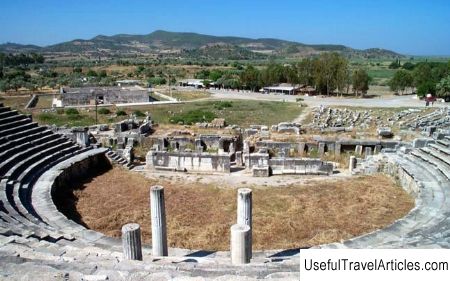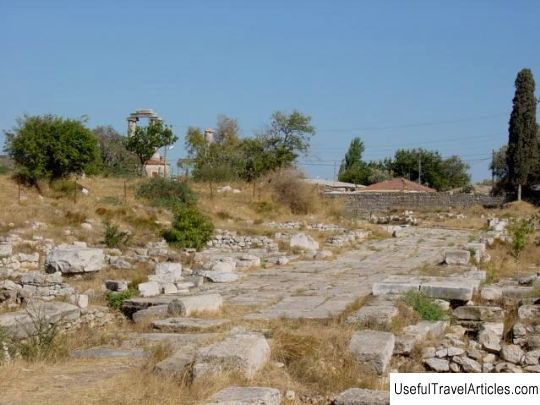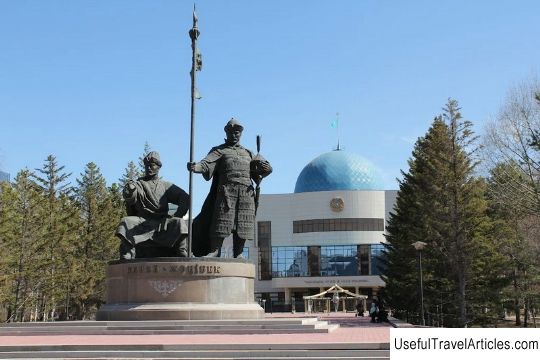Miletus description and photos - Turkey
Rating: 8,1/10 (865 votes) 
Miletus description and photo - Turkey. Detailed information about the attraction. Description, photographs and a map showing the nearest significant objects. The name in English is Miletus. Photo and descriptionSouth of the mouth of the Big Menderes River, which in ancient times was called the Meander, are the ruins of one of the once most powerful and wealthy Ionian cities. Miletus or Miletus was founded in the second half of the fourth millennium BC, around 3500 - 3000 BC. Located on the western coast of Anatolia in Turkey, the city was considered an important center of philosophy and the exact sciences of the time. Herodotus called it "the pearl of Ionia". Greek scientists created a school of philosophy here, and such great minds of mankind as Thales, Anaximander and Anaximenes were engaged in scientific works in the city. Thales, Anaximander and Anaximenes gave lectures here about the structure of the world, life, were engaged in astronomy and geometry. The city was located in the northwestern part of the peninsula, and its natural border was the Bay of Heracles, into which the Meander flowed - the most full-flowing river in Asia Minor, flowing into the Aegean Sea. The peninsula bordered on the spurs of the Carian Mountains in the east. In the south, the polis was washed by the Bay of Mendelia, and in the west it bordered the Aegean Sea. In this area, small valleys gave way to mountainous plateaus, and rivers flowed along the ravines, irrigating fields and pastures. Thanks to such an abundance of mountain springs, the inhabitants of the polis successfully engaged in agriculture, horticulture and winemaking. Since the city has found the texts of linear writing and fragments of Minoan style frescoes, it is believed that the first settlements arose here in the Neolithic period. According to legend, the city was founded by a hero named Miletus, who moved here from Crete. At the same time as Miletus, eleven other Ionian cities were founded or settled, as well as 12 poleis of Aeolia. Together with these cities, the policy was part of the so-called Panionian religious union, which was formed around 700 BC, and was recognized as the head of the union. Due to its favorable location, trade and shipping were developed in the city. The merchant ships of Miletus crossed the entire Mediterranean Sea, and often entered the Pontus Euxine (Black Sea), up to the mouth of the Tanais (Don) River. On the banks of the Pontus Miletus, during its heyday, owned 80-90 colonies. The Miletus colony was even in Ancient Egypt. The policy was divided into external and internal parts. The last of them had a special fortress, both parts of which were surrounded by one wall. The city had four harbors, protected from the sea by the Tragasai Islands. Miletus has repeatedly had to defend his independence. He fought against the Lydian kings and the Persian rulers. The fourth century BC was the period of the highest flowering of science and culture of the polis. The tyrants of the city during this period maintained friendly relations with the Persian kings. But already in 494 BC, the city was captured by the Persians and destroyed. The Greeks soon settled here again. The brilliant heyday of Miletus falls on the Roman era, but in Byzantine times the city fell into decay and lost its former significance as a result of the flooding of the port. Its significance has dramatically decreased since the time of its secondary destruction by Alexander the Great. Now on the site of the city stands the poor village of Palatia, and the ancient city of Miletus is a well-preserved ruin. In the city, you can see the well-preserved ruins of an ancient theater that once held 15 thousand spectators. This most magnificent building in Miletus dates back to the Roman period and is located immediately at the entrance behind the ticket office. The theater was built in the second century on the foundations of an older Greek theater. It is located on the slope of the only hill in the city. The dimensions of the structure are impressive: the diameter of its amphitheater is 140 meters, and the height is 30 meters. Above the theater are the ruins of a Byzantine castle dating from the 8th century, and fragments of the once rather long city walls, which were fenced with a double ring parts of the city. From here, an excellent view of the entire polis opens. If you go down from this observation deck to the city center, the road will pass Hellenistic tombs, behind which is a small round foundation. In the first century BC, there was a monument in honor of the victory in a naval battle. At that time, he was on the shore of the Lion Bay, on the shore of which stone lions were found. The colonnade located here led to the temple of Apollo of Delphi, the patron saint of ships, ports and sailors. This sanctuary was founded in ancient times, but was reconstructed twice. During the Hellenistic era, the building was restored in the Doric style, and in the Roman period, the porticoes of the temple were converted to Corinthian. The famous baths of Faustina, built around 150 AD, are well preserved in Miletus. They were dedicated to the extravagant wife of Marcus Aurelius and were a gift from the emperor to the city. The baths copied the Roman, so to speak, the forerunner of the Turkish baths (hamam). Their central courtyard was surrounded by Corinthian columns, and the gymnasium could be accessed through the apoditerium, the undressing room where the statues of the Muses stood (now in the Istanbul Museum). The frigidarium of the baths was also decorated with sculptures that used to be the fountains of the central pool. One of them represented the local deity Meander, and the other was made in the form of a lion's head. The most unexpected in the territory of Miletus is the building of the mosque, an example of early Turkish-Ottoman architecture that delights tourists with skillful stone carvings. The mosque was built at the beginning of the 15th century by Emir Menteshe Ilyas-bey in gratitude for his safe return from captivity at Tamerlane. This small building is decorated with marble slabs and is crowned with a graceful dome. There was one minaret in the building, which collapsed during an earthquake in 1958. Previously, there was a caravanserai and a madrasah at the temple, but now on the grassy courtyard you can see only tombstones standing and lying in disarray. Also in Miletus you can see the remaining half of the once huge fountain, a partially restored Ionic portico, northern Agora (market square). To the west of it are the ruins of the temple of Serapia dating from the 3rd century. Most of the rest of the buildings of the Hellenic and Roman era are hidden behind dense thickets of thorny bushes or underground. The best time to visit Miletus is in spring, when fresh greenery and flowers surround the ruins. An interesting fact is that the name of the Milesians became a proverb among the ancients and was used to designate happy and successful people, so to speak, "darlings of happiness."       We also recommend reading Maritime Museum (Pomorski musej) description and photos - Montenegro: Kotor Topic: Miletus description and photos - Turkey. |




